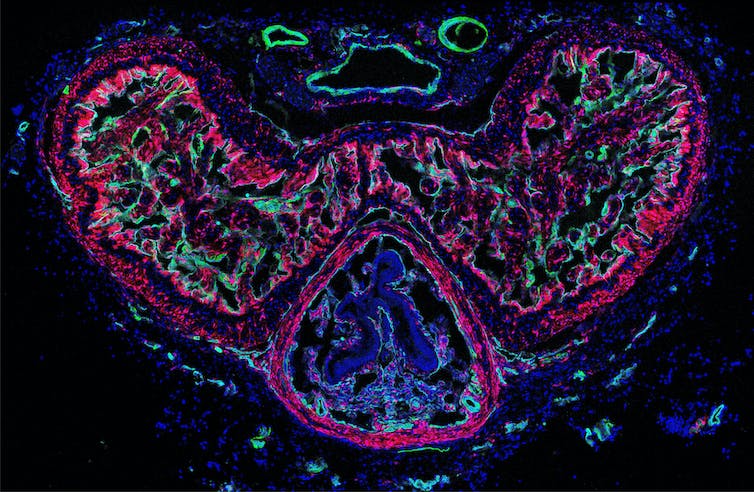Have you ever wondered how penile erection works but never dared to ask? Well, imagine a dry sponge in a condom. Now pour water on the sponge (that’s the blood flowing in). There you have it.
This penis “sponge” is scientifically termed corpora cavernosa. Erections depend on the influx and trapping of blood. Smooth muscle cells regulate the blood flow into the sponge and its subsequent firmness. In a recent study, my colleague and I delved into the role of penile fibroblasts, the most abundant cells in the human penis, about which little was previously known.
We discovered that penile fibroblasts help smooth muscle cells to relax. Using a technique to render cells light-sensitive enabled us to activate fibroblasts by shining blue light from outside onto the penises of mice.
We found that light-induced activation of fibroblasts relaxed smooth muscle cells and increased blood flow. The effectiveness of this relaxation-support depends on the number of fibroblasts. More fibroblasts led to easier relaxation and increased blood flow.
We also learned that the number of fibroblasts is not static and identified the signalling molecules regulating the number of fibroblasts in the penis. By deleting or over-expressing the relevant molecules, we could increase or decrease the number of fibroblasts and in response see the corresponding changes in penile blood flow.
But we quickly learned that too many fibroblasts has negative consequences. Mice with very high numbers of penile fibroblasts showed erections that lasted for several hours. In men, this corresponds to a painful pathological condition termed priapism, which demands a visit to the hospital.
Can penile erection be trained? In humans, much of the “erectile training” occurs naturally during sleep, with men experiencing three to five erections a night, known as “nocturnal penile tumescence”.
To test the importance of training, we artificially changed the frequency of erections in mice by targeting the brain region responsible for initiating an erection. This technique allowed us to turn erections on and off by simply administrating a designer drug that specifically activated the responsible nerve cells in the mouse brain.
Eduardo Guimaraes, Author provided (no reuse)
More fibroblasts, more blood flow
Surprisingly, we found that the number of penile fibroblasts changed in relation to the frequency of erections. The more frequent the erections, the more fibroblasts were present and the better the blood flow. This implies that it becomes easier to initiate and maintain an erection with increased erection frequency.
It is known that the unconscious “training” during sleep declines with increasing age. Ageing is one of the major risk factors for erectile dysfunction in men.
Studying penises of aged mice, we found that they possessed a lower number of fibroblasts compared with young mice. When reducing the number of recurrent erections in young animals for a longer time, we found a decrease in the number of fibroblasts and lower penile blood flow.
One interpretation could be that reduced training negatively affects the number of fibroblasts and consequently, it becomes less efficient to initiate an erection.
While the spontaneous occurrence of erections during sleep is certainly convenient, our study does not suggest any differences between involuntary and actively evoked erections regarding the number of penile fibroblasts. So, an age-related decline of nocturnal penile tumescence could be a potential target for future treatment of erectile dysfunction or compensated for by actively achieving an erection.
Our research unveils a mechanism for controlling penile erections, opening the door for further exploration to understand and improve sexual health.




